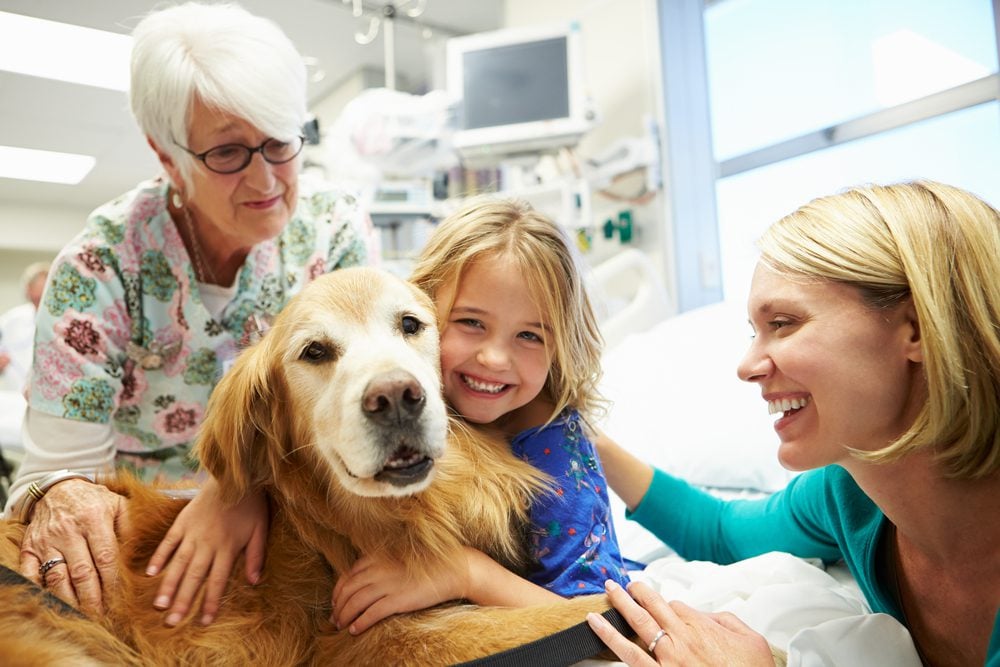Dogs and humans have an undeniably special connection. Their soft fur, wagging tails, and adorable faces are certain to lift our spirits. Not to mention, some dogs seem to be empathetic, showing us extra love or attention whenever we’re feeling down.
These qualities make dogs the perfect candidates to visit people who could use a little extra love. Of course, not every dog is going to be perfect for therapy work. If you’re interested in taking a dog to visit people in hospitals, schools, nursing homes, and the like, then you’ll need a dog who is well-behaved and loves people.
In this article, we will be sharing everything you need to know about therapy dogs. We’ll explain exactly what a therapy dog is, what they do, and how they differ from other types of support animals. We’ll outline the qualifications a dog needs to do therapy work, and finally, we will discuss some of the best breeds for the job.
What Is a Therapy Dog?
The name “therapy dog” can be somewhat misleading. Some people think this kind of dog is meant to provide them with relief from a mental or physical disability, but that is not the case. Here, we will explain the difference between service dogs, emotional support animals, and therapy dogs.
Service Dogs
Service dogs perform tasks that assist their handlers with their disabilities. Some of the most well-known service dogs are guide dogs for the blind, but there are many different types of service dogs that can aid with many different disabilities.
There are even psychiatric service dogs (PSDs) who are trained skills like deep pressure therapy in order to help handlers who suffer from mental disabilities. In that sense, they might be thought of as therapy dogs, but they are technically service dogs.
Service dogs are highly trained and are given special privileges such as being allowed in businesses and in airplane cabins. No other types of assistance dogs are allowed these privileges.
Emotional Support Animals
Emotional support animals (ESAs) can be any type of animal, but we’ll focus on dogs since that’s what this article is all about! Many people find comfort in dogs as companions, and that is exactly the purpose of an ESA.
Interacting with a dog on a daily basis and being able to enjoy their unconditional love can be very beneficial to those struggling with mental health disorders. This is why some doctors will prescribe patients an emotional support animal.
These dogs do not require any special training, nor do they need to perform any skills to be of help to their owners. Rather, their presence in itself typically provides comfort. Thanks to the Fair Housing Act, emotional support animals are allowed to live with their owners for free, even in places that don’t allow pets; they also are exempt from breed and weight restrictions, and you cannot be charged any type of pet fee for living with them. Otherwise, they have no special privileges.
Therapy Dogs
The word “therapy” may lead you to believe that a therapy dog performs special skills that provide some type of therapy, but this isn’t the case. Instead, therapy dogs bring comfort to those in lonely or unfortunate situations.
For instance, a therapy dog might be brought to visit children in a hospital or elderly people in nursing homes. The children may be struggling with difficult health issues and being able to meet a dog often brightens their day.
Elderly people can suffer from loneliness, especially if they have diseases such as Alzheimer’s that cause them to forget their loved ones have visited. Even in less severe circumstances, therapy dogs bring happiness wherever they go. In fact, petting a dog for just ten minutes can help relieve stress.
There is also something known as animal-assisted therapy. This is when professional therapists bring animals into therapy sessions in order to help patients feel more comfortable. In some cases, patients are more forthcoming about their issues when in the presence of dogs.
However, these types of therapy dogs aren’t typically owned by private citizens. If you’re looking to help people with a therapy dog, you’ll likely be visiting different places with your dog, as we’ve previously described.



Therapy Dog Qualifications
There are no breed requirements for therapy dogs. Any dog could be a therapy dog, even a mixed breed from a rescue! It’s much more important for therapy dogs to be well-behaved and good with people.
A dog that is overly rambunctious could hurt people on accident, and a dog that doesn’t enjoy interacting with people and being hugged and touched will essentially suffer every time they’re taken out for a visit.
While there are no qualifications when it comes to breed, therapy dogs must be adults. Furthermore, you have to get a therapy dog certification before you can start visiting those in need. The first step to this is usually to pass the American Kennel Club’s (AKC) Canine Good Citizen test. This test proves that your dog is well-mannered and obedient.
From there, you can seek certification from a nationally recognized organization. The AKC has a list of such organizations on its website. Some organizations may require you and your dog to pass another test in person, while others will provide certification as long as a dog has passed the Canine Good Citizen test.
What to Look For in a Therapy Dog
The purpose of recommending specific breeds is because some are well known for having qualities that make them suitable as therapy dogs. If you’re planning to get a dog that’s a puppy, then it can be difficult to know if they will grow up with a suitable temperament for therapy work.
However, if you choose a breed well known for its temperament, you may have better luck. That said, just about any dog could become a therapy dog regardless of breed. Personality and behavior are much more important than the breed.
Here, we will talk about the traits that make a good therapy dog as well as other considerations you should make to ensure a dog is the right fit for your purpose and lifestyle.
Temperament
Therapy dogs should be both friendly and calm. It’s important that these dogs like people and enjoy interacting with them because that’s exactly what they’ll be doing. Friendliness is a must, but it shouldn’t be overbearing.
Many of the people a therapy dog visits may be elderly or have some sort of condition or disability. Exuberance is undesirable as it could lead to injury in the worst-case scenario. This is why being calm is a necessity for therapy dogs.
However, this doesn’t mean that therapy dogs can’t be playful. For example, a therapy dog visiting children in an after-school program could bring a lot of joy if the dog is interested in running around with the kids and playing fetch or frisbee.
Overall, a therapy dog should be friendly, patient, and good-mannered. While these traits will depend, to some extent, on the dog’s inherent nature, socialization and training can do a lot to help a dog become friendly and well-behaved.
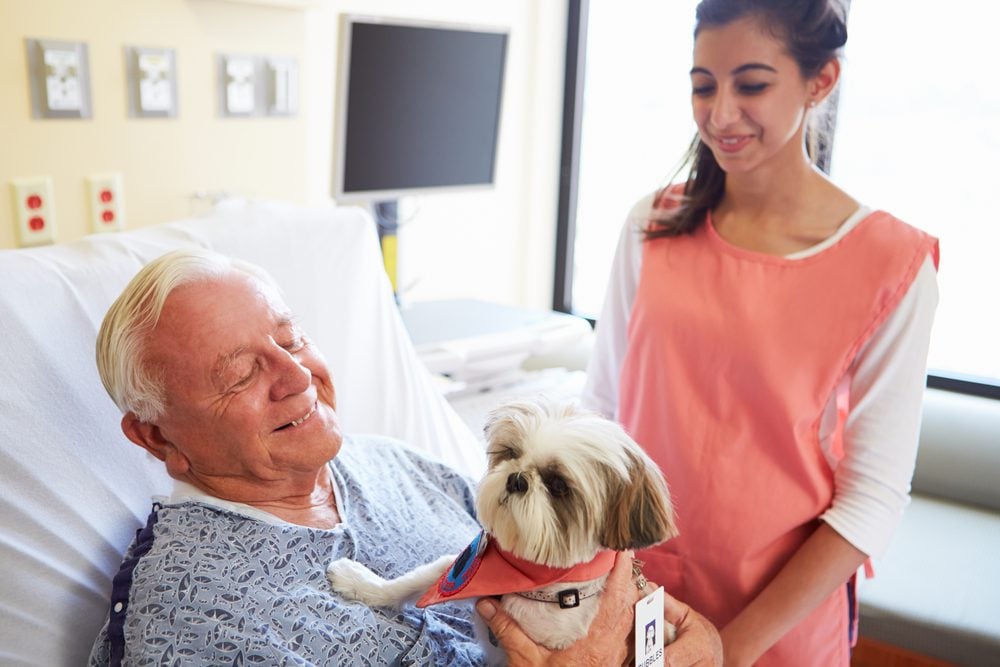


Size
It’s important to take into consideration a breed’s size. Not only does the dog’s size need to match your own personal needs (for instance, if you live in a small apartment, you may have no other option than a small breed), but it should also suit your purpose.
Small dogs are great because they are lap-sized. They can be placed in hospital beds where patients can stroke and cuddle them. This would be especially nice for patients who are bedridden and cannot get up to reach a larger dog sitting at their bedside.
Larger dogs, on the other hand, can sometimes be the better choice when working with children. Some children, especially young children, may struggle to be gentle with dogs. Large breeds are unlikely to be hurt or bothered by a child’s awkward patting and grabbing.
Energy Level
One of the most important things to consider when getting a dog is their energy level. High-energy breeds like border collies need at least two hours of moderate exercise per day, often more.
Many high-energy breeds are also incredibly smart. This can be disastrous if the dog does not get enough physical and mental enrichment. Yes, aside from exercising your dog, you need to provide them with brain activities such as training or puzzle games.
High-energy breeds can be quite a bit of work and thus are not the right choice for everyone. However, if you are able to dedicate appropriate time and care for such a breed, they can make for some of the best therapy dogs.
Their energy levels allow them to easily keep up with kids in a setting where interactions can include play. Breeds like border collies can be taught amazing tricks and skills that will bring smiles to the faces of the people they meet.
Care and Grooming
All dogs require care, but some may need more than others. For example, a poodle may need to be professionally groomed while a Labrador retriever only needs to be brushed on occasion.
You’ll want to consider what kind of coat a dog has and whether or not you have the time, money, or willpower to care for such a coat. If you want a low-maintenance breed, then you’ll typically want to stay away from long or curly-haired dogs.
Some dogs are also more prone to medical issues. Flat-faced breeds may develop brachycephaly (difficulty breathing). Large breeds are prone to arthritis in old age and could also develop hip or elbow dysplasia.
While there is no guarantee that your dog would develop any health conditions, knowing the possibilities can help you be prepared financially. In general, small breeds tend to be less expensive than large breeds when it comes to veterinary bills and even food costs.
The Best Breeds for Therapy Dog Work
Though any dog of any breed could be good for therapy work, there are some breeds that tend to have the type of personality one looks for in therapy work. The breeds on this list tend to be friendly, good with kids, and highly trainable. We’ll be sure to share a bit of information about each breed’s needs as well, so you’ll have an idea if such a dog would suit your lifestyle.
1. Labrador Retriever
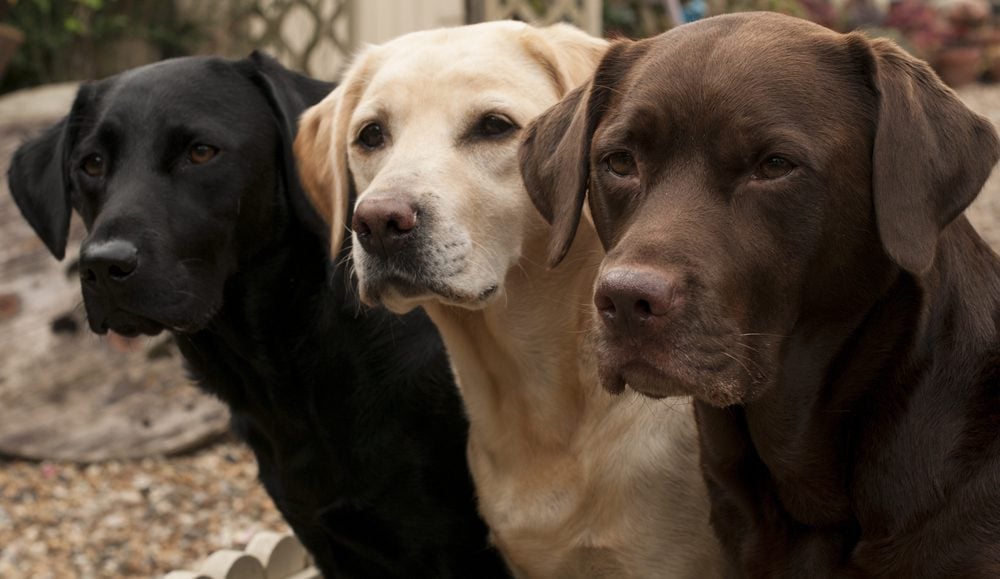


Labrador retrievers are well known for their friendly, happy-go-lucky natures. In fact, they are one of the most popular dog breeds in the USA both in terms of family companionship and service work.
Labradors adore people and are good with any age group. Not only can they be quite affectionate, but they’re also easy to train because they want to receive praise from their humans. Labs have above-average energy levels, but would not necessarily be considered high energy.
They adore playing fetch, which can be an easy way to exercise them. Their short coats shed a lot, which can make brushing once per week ideal, but they can go without being brushed for weeks and it won’t impact them negatively (though you will find a lot more hair around the house).
The Labrador retriever is a happy, friendly breed and is typically known as a classic “family dog.” They are prime choices for all types of service dog work, from guide dogs and medical alert dogs to psychiatric service dogs, and they are also great as therapy dogs. Labrador retrievers are intelligent, love to learn new tasks, and are both calm and patient. This dog is another breed that is an especially good choice for working with children.
2. Golden Retriever
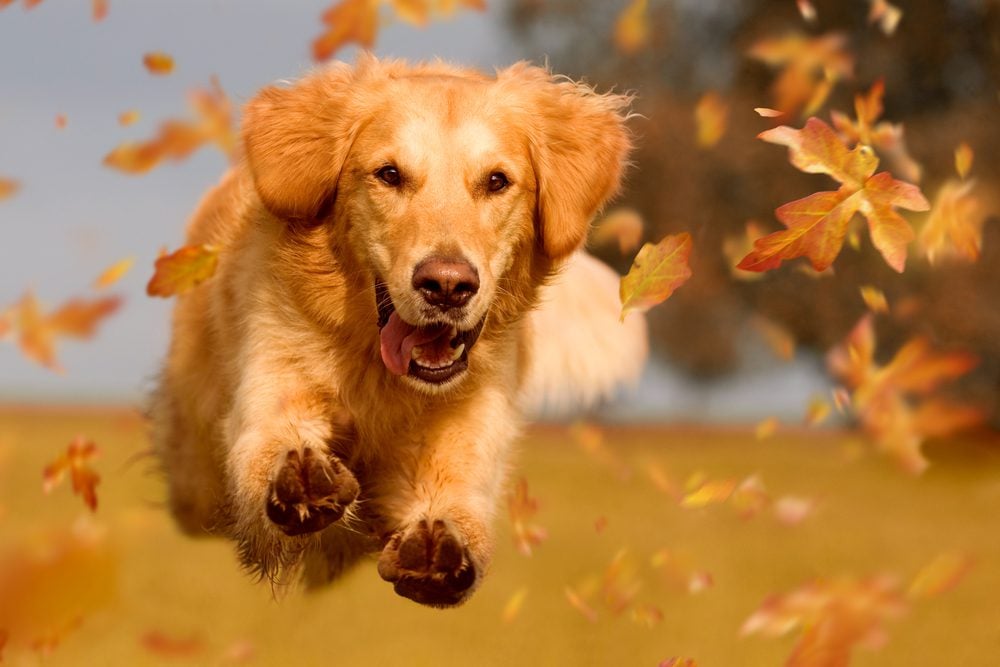


Golden retrievers are similar to Labradors in that they adore people of all ages and tend to have friendly, outgoing personalities. They’re also a popular choice of companion animal and service dog.
As their name suggests, goldens love to retrieve, and playing fetch can be a fun activity for kids you may be visiting; it’s also great exercise! As far as training is concerned, golden retrievers are typically eager to please and thus easy to train.
Because their fur is long, they do need to be brushed at least once per week, though sometimes more frequent brushing may be required. It’s important to take the time to do this or the golden retriever’s hair can become tangled and matted. Extreme matting can actually cause skin irritation and be painful for the dog.
This breed is gentle, loving, and affectionate, and golden retrievers are well-loved for the bonds they make with their families. They are eager to please and focused when it comes to training and can easily learn new tasks or skills. Additionally, they are very aligned with their owner’s emotions most of the time.
Golden retrievers are an especially good choice as therapy dogs for children or young adults, thanks to their loving and calm nature.
3. Poodle



The great thing about the poodle is that it comes in three different size categories: standard, toy, and miniature. There are some slight variances in temperament between the three sizes, but for the most part, poodles are smart, affectionate, and good with children.
Another nice thing about poodles is that they do not shed very much at all. They are considered hypoallergenic; while no dog is truly 100% hypoallergenic, poodles are one of the least likely to irritate those with allergies.
However, their coat requires extra care. Many prefer to have professional groomers shave their poodles, as a long coat requires a lot of management. You can learn how to shave a poodle’s coat yourself if you’d prefer to save money.
4. Newfoundland



The Newfoundland is most definitely a gentle giant. Though their size may be intimidating, Newfoundlands tend to be very friendly and absolutely love meeting new people. They’re also gentle and patient with children, which has led many to refer to this breed as a “nanny dog.”
When it comes to training, this breed isn’t quite as eager to please as others on our list and may not be the best choice for someone with little experience. However, someone who can provide clear instruction via positive reinforcement can certainly train a Newfie to be a well-mannered therapy dog.
Newfies have a somewhat long, shaggy coat that requires brushing at least once per week. They’ll need more frequent brushing during the shedding seasons (usually spring and fall).
5. Border Collie
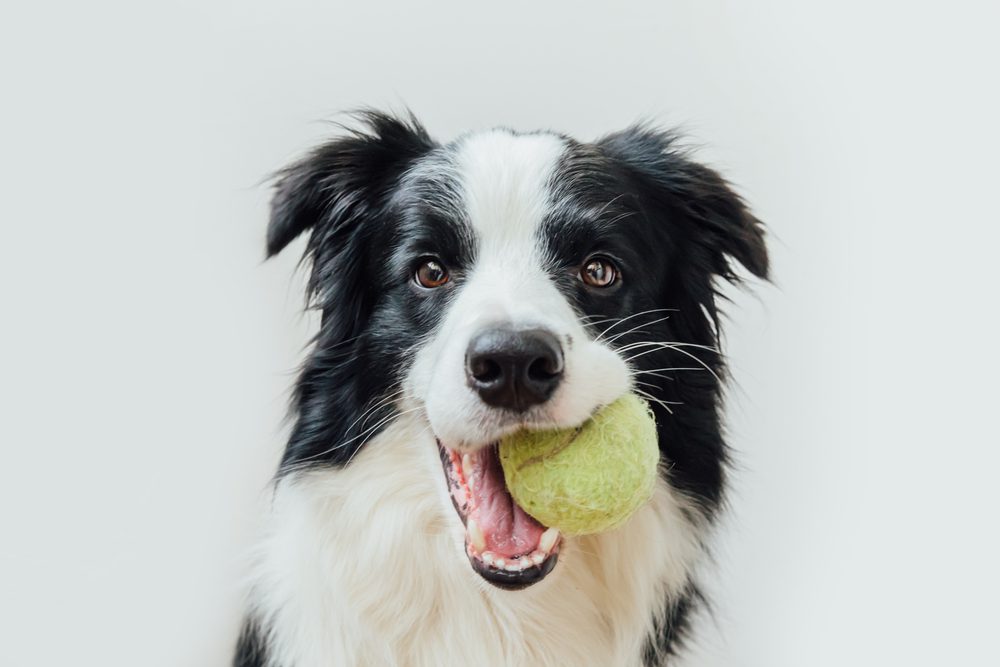


Border collies are the smartest breed on this list, and they can be trained to do incredible things. The best part is that they like being trained. Border collies flourish when given a job to do, and it’s vital that they have one. They are incredibly high energy and need hours of physical and mental exercise every day in order to prevent destructive or anxious behaviors that can result from boredom.
These dogs make great therapy dogs because they are so talented when it comes to training. Not only that, but they’re also usually friendly with strangers. However, they don’t always do so well with kids.
Border collies have herding tendencies and it is not uncommon for them to try to herd young children by nipping at their heels. This can be remedied with training, but it’s important to know that a border collie therapy dog may be better suited to visits with adults. Border collies need to be brushed about twice per week to prevent the hair from matting.
6. Cavalier King Charles Spaniel
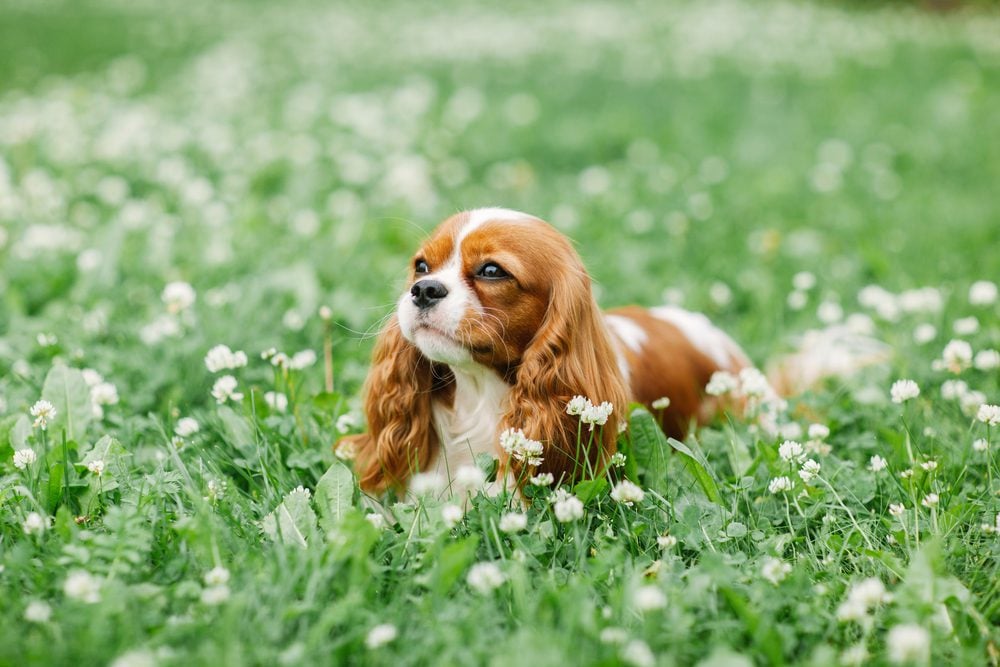


If you’re looking for a small therapy dog, the Cavalier King Charles spaniel is a great option. There’s often a stigma about small dogs being grumpy, but this definitely isn’t the case with the Cavalier King Charles spaniel. This breed is affectionate and friendly as well as good with kids.
They aren’t excessively energetic but still enjoy a good romp and are the perfect size to be placed in someone’s lap. King Charles spaniels are also easy to train. Because they have long hair, they do need to be brushed at least once per week.
Known for their sweet and playful nature, this breed loves having tasks to complete and is eager to please. They also love affection and will spend as much time with their owner as possible, making them a great choice for a playful, loving, and comforting therapy dog.
7. Bichon Frise
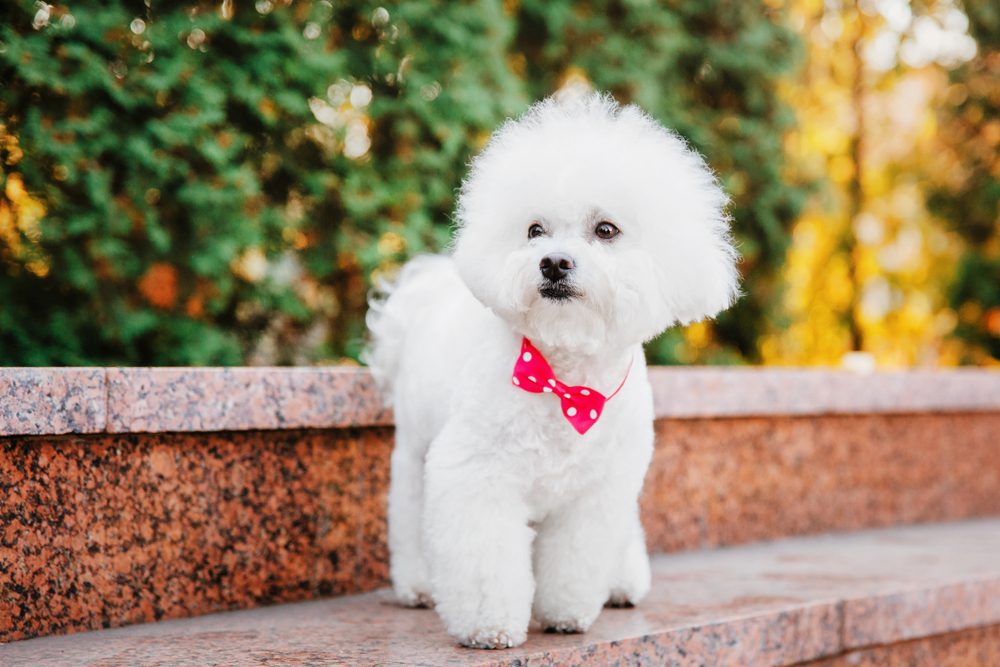


Bichon Frises are considered to be curious, playful, and happy-go-lucky dogs. They are quite loving toward their families and don’t know the definition of stranger — everyone is their friend! They also get along well with kids because they are patient, gentle, and spunky.
They have a fair bit of energy, though they are much easier to manage than other high-energy breeds due to their small stature. Bichon Frises enjoy reward-based training and are eager to please, making them relatively easy to train.
Like poodles, they shed very little so their coats will be far less irritating to those with allergies. However, their coat requires extra care, and they should be brushed anywhere from daily to three times per week to prevent the hair from tangling and matting. The coat also needs to be clipped every four to six weeks.
Gentle, friendly, and loving, the Bichon Frise is a great breed for those who want an affectionate therapy dog. Bichon Frises are surprisingly intelligent and quite cheerful, and they can easily brighten up anyone’s day or act as a constant source of comfort.
8. Yorkshire Terrier
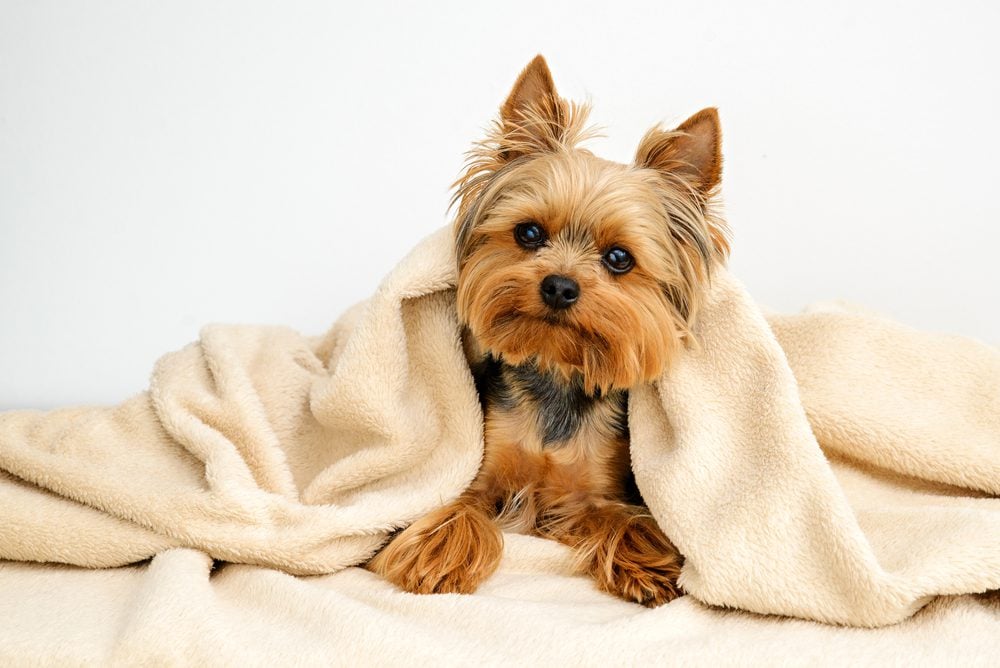


Yorkshire terriers, or Yorkies, can also be great therapy dogs because they see everyone as a friend. They’re great with young kids and are easy to train. They can be quite playful and are considered a high-energy breed. However, their small stature means that a couple of short walks every day is enough to keep them from feeling bored.
The silky texture of their long hair is somewhat similar to our own human hair, and this, paired with their minimal shedding, makes them less irritating to people with pet allergies. Of course, their luxurious hair requires a lot of maintenance.
Those that choose to keep the hair long will be brushing it daily, possibly every time the dog is brought in from outside. Yorkies with long hair will also need weekly bathing as their hair touches the ground and may be dragged through dirt and debris. Many owners opt to have the Yorkie’s hair cut close to the body as it is much easier to care for and comparably low maintenance.
Yorkshire terriers might have somewhat of a reputation for being loud and bossy, but these dogs are highly intuitive. This dog breed is known for picking up on the feelings of people easily, and they will often act accordingly to what they are sensing.
9. Corgis
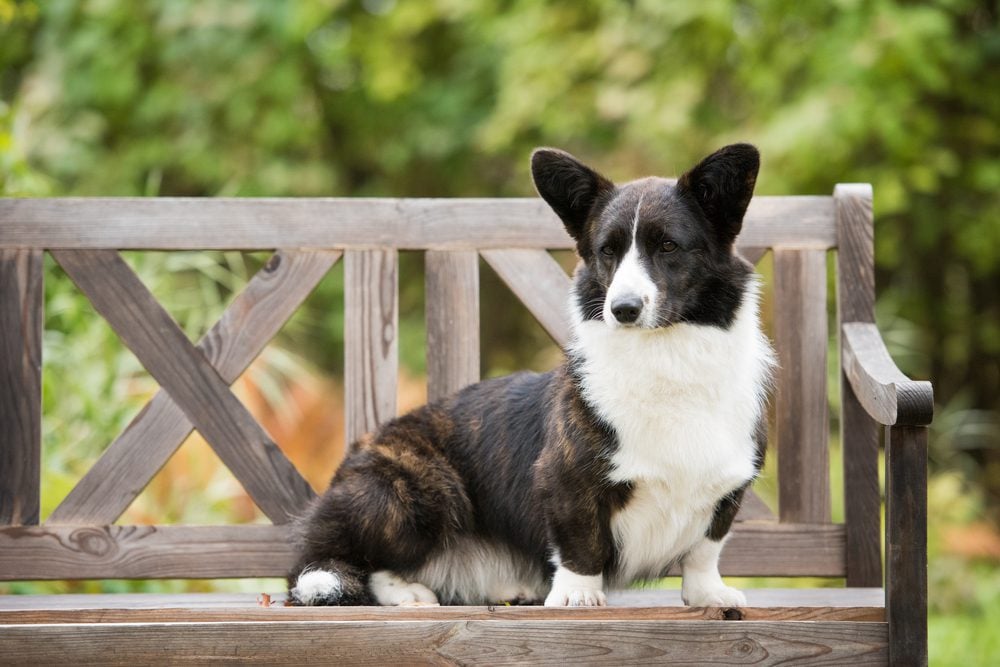


When people think of corgis, they usually think of the tan and white Pembroke Welsh corgi. While a Pembroke would also make a good therapy dog, we think Cardigan Welsh corgis are slightly more well-rounded, mainly because they are more likely to do well with kids.
However, these cousin breeds are quite similar otherwise. They are both amicable toward strangers and easy to train. Their grooming needs are similar in that a weekly brushing is all that is needed, though it should be noted the Pembroke sheds slightly more and the Cardigan has a longer coat.
Both breeds will require more frequent brushing during shedding season. It is also beneficial to shave out the hair in the Cardigan’s paws to prevent them from becoming matted.
If you were wondering how to tell these breeds apart, look for a tail. The Pembroke Welsh corgi has but a small nub for a tail, whereas the Cardigan Welsh corgi has a full-length, bushy tail.
Even though some corgis have a stubborn streak, this breed is friendly, sociable, and loving. Corgis love to be the center of attention, and they will have no problem being touched or petted on a regular basis as people seek comfort from their happy demeanor.
10. Papillon
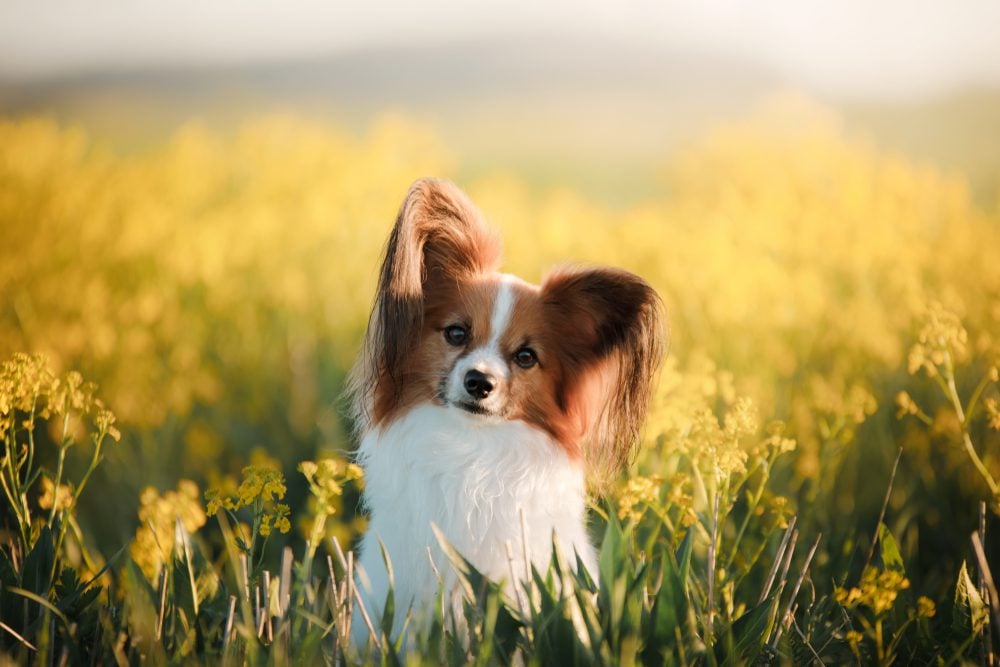


“Papillon” is the French word for butterfly and refers to the shape of this breed’s ears. However, we would argue that papillons are also butterflies in the social sense. They see everyone, even strangers, as their best friends.
Despite their small size, Papillons are considered hardy and robust. This, coupled with their agility and near-constant desire to play, means they are great at interacting with kids. They’re also easy to train and can be taught fun tricks (another thing kids love!).
Papillons are considered high-energy, but their small size means you won’t have to worry about spending hours exercising them. A walk around the block or romp in the yard is usually enough. You can easily play fetch indoors on rainy days, but puzzle toys are also a great option.
Papillons have long hair but surprisingly don’t need much grooming. Simply brush them about once a week to prevent matting and bathe them every few months as needed.
11. Pug



The pug is a breed that you might not automatically think of when you consider therapy dogs, but this breed makes for a fantastic therapy companion.
While pugs are too small to complete significant service dog tasks such as retrieving items, clearing rooms, or providing pressure therapy, they are very loving and affectionate therapy dogs. Plus, their small size can make them less intimidating to young children or people who may be on edge (which is common for those who therapy dogs support).
They are cuddly and love spending all their time with people, making them a great choice for a therapy animal. They are also gentle and great with children, happily soaking up any attention or playtime that comes their way.
12. Greyhound
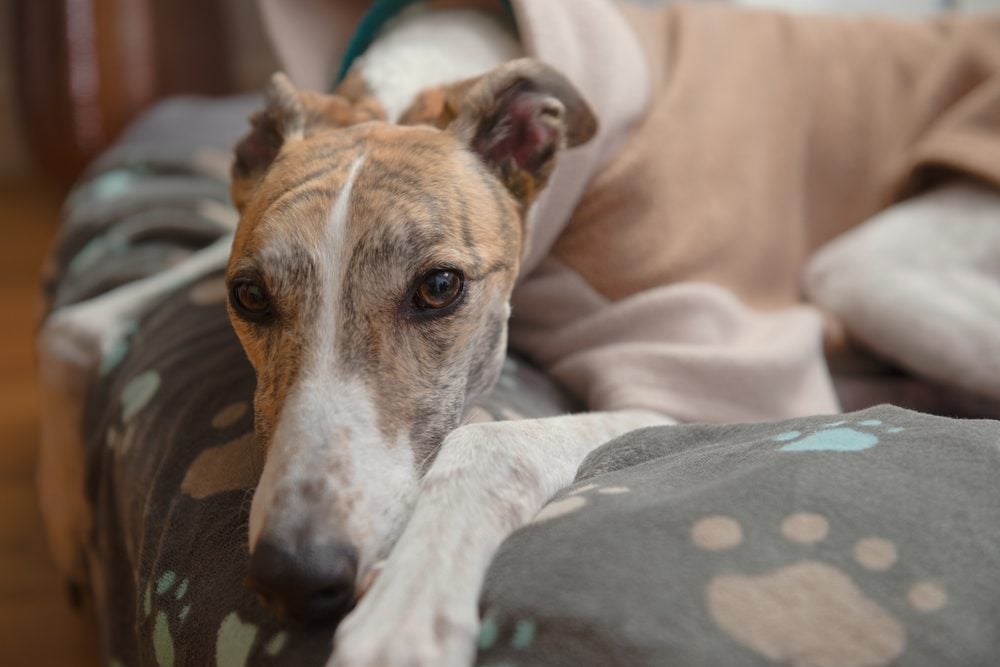


An often overlooked breed for therapy dog work, the greyhound is actually an excellent choice.
Greyhounds have short bursts of energy, and once they receive enough playtime and outdoor walks for the day, they want nothing more than to curl up with people or laze around and soak in affection.
This makes them great candidates for therapy tasks requiring a gentle sense of companionship. Greyhounds are also intelligent, highly focused, and love learning new things, so they can easily be trained for more advanced obedience work.
13. Beagle
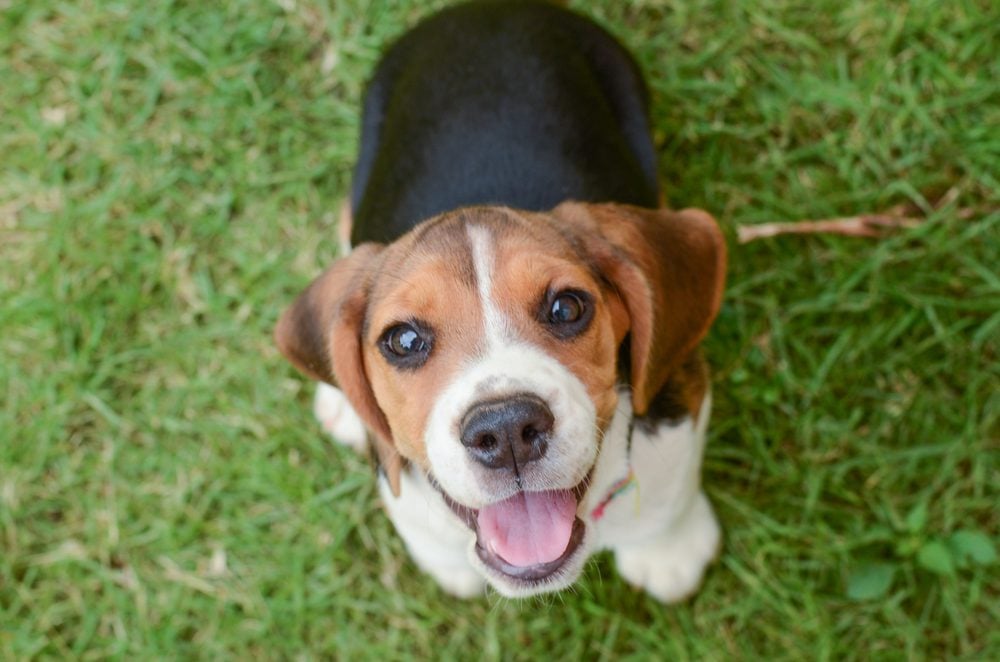


Beagles have a friendly disposition, love to be around people, and enjoy soaking up all of the attention directed at them.
They make a great choice for therapy dogs that spend time around children due to their playful and gentle nature, and they love spending as much time as possible with people.
However, beagles are quite stubborn and highly intelligent, so proper training is necessary to ensure your pup doesn’t get into trouble when they’re out with you.
14. Dachshund



The dachshund is a fearless lap dog with a reputation for being loving and active.
Dachshunds are on the smaller size for therapy work, so while they won’t necessarily be able to complete service tasks such as guiding and deep pressure therapy, they can provide a sense of comfort as they snuggle up with people during every possible moment.
Additionally, dachshunds are generally eager to please and can be trained without too much trouble, and they are both active and fun-loving, making them a great choice for a therapy dog that loves to be out and about.
Any Breed Could Be a Therapy Dog
Therapy dogs bring comfort and joy to those who may be lonely, ill, or otherwise in need of a four-legged friend. There is no one perfect breed for therapy work. In fact, any breed could do it as long as they have the right personality!
Therapy dogs need to enjoy interacting with people (especially strangers) and be well-mannered and obedient. While some breeds are more likely to exhibit these qualities, any dog that has them could become a therapy dog. In the end, what is most important is if a dog is able to provide warmth and companionship to those who need it most.
